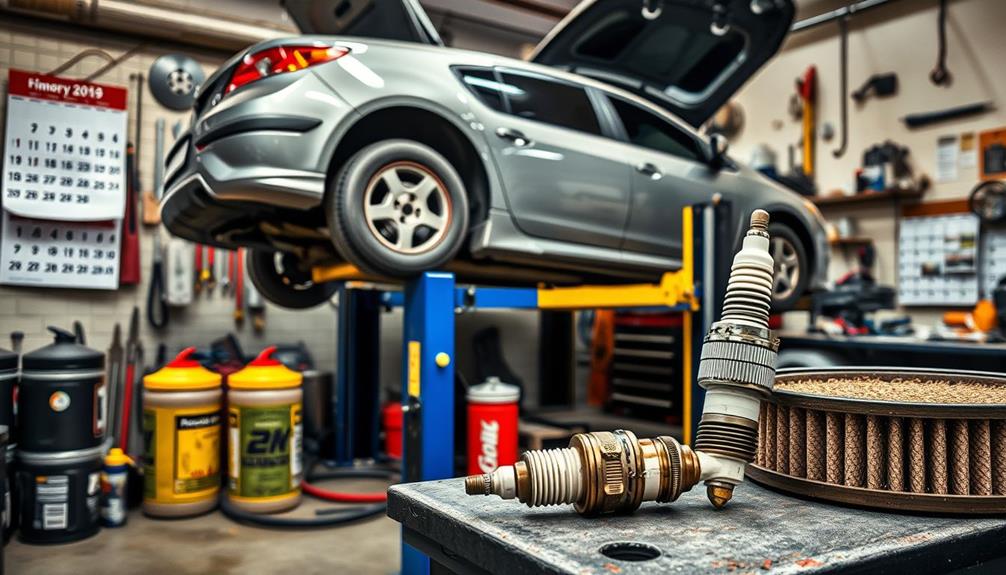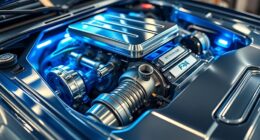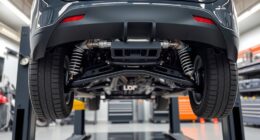To remap your ECU safely, start by connecting your scanner to the OBD-II port and backing up your original data. Carefully identify key parameters like fuel, ignition, and boost settings. Make precise adjustments using compatible software, then re-upload the modified map to the ECU while ensuring stable power. Afterward, conduct tests or use a dynamometer to confirm improved performance. If you want a straightforward process that balances power and safety, continuing will guide you through each step.
Key Takeaways
- Safely connect to the ECU via OBD-II port, back up original data, and verify device compatibility before proceeding.
- Identify and understand key ECU parameters like fuel maps, ignition timing, and boost levels for precise adjustments.
- Make incremental modifications using specialized software, ensuring stable power supply and avoiding hardware conflicts.
- Reflash the ECU with the modified map, then verify successful upload and restart the vehicle for changes to take effect.
- Conduct testing with diagnostic tools or dynamometer, monitor live data, and fine-tune settings to optimize performance safely.
Understanding Your Vehicle’s ECU Baseline
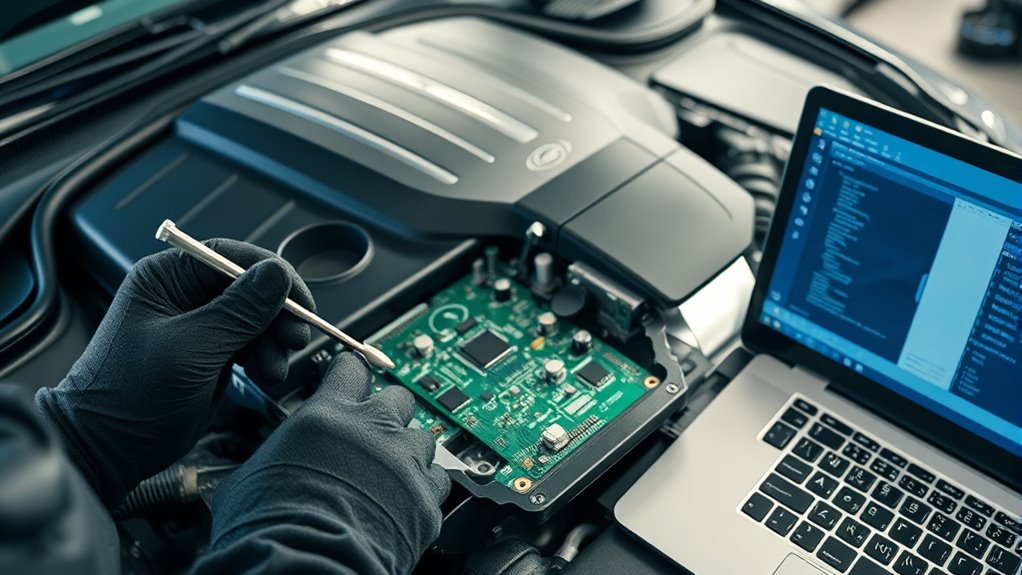
To effectively remap your vehicle’s ECU, you first need to understand its baseline configuration. This involves accessing the ECU via the OBD-II port, where you can log essential engine data.
You’ll want to verify sensor calibration, ensuring oxygen, airflow, and temperature sensors are accurate. The ECU processes sensor inputs through its microcontroller, which executes control algorithms to manage fuel injection, ignition timing, and actuator commands. Microcontroller functionality is crucial for precise engine management and performance tuning.
It also monitors power levels to maintain stable voltage for internal and external components. Key parameters like fuel injection timing, ignition advance, boost limits, and rev limiters are set from the factory.
Analyzing baseline performance—such as torque curves, fuel trims, and knock activity—helps identify areas for improvement. Understanding these core aspects lays the foundation for a successful remap. ECU tuning involves modifying these parameters to optimize performance and efficiency based on your specific needs.
Extracting the ECU Data Safely
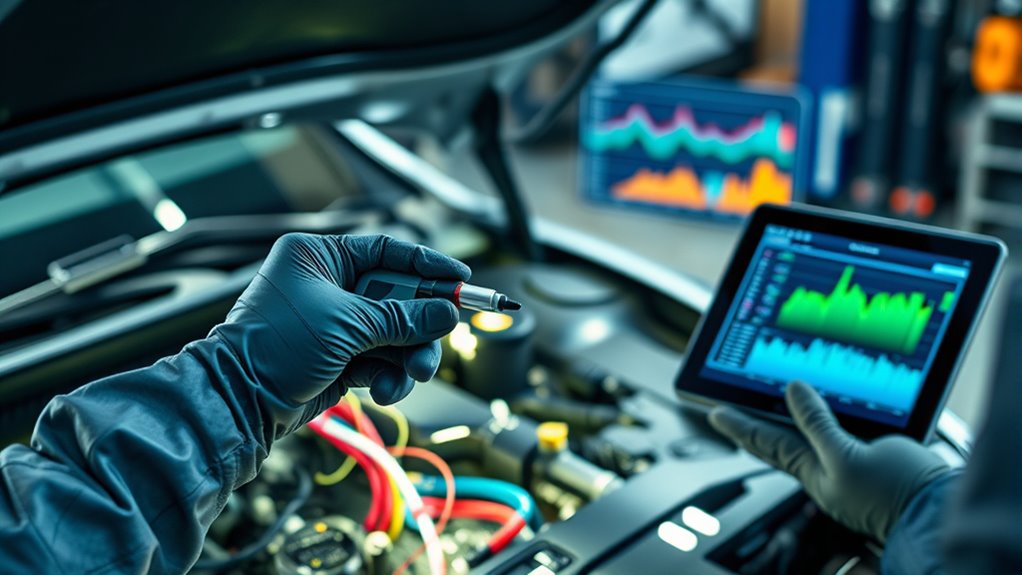
Extracting ECU data safely is essential to guarantee damage prevention and ensure accurate results. First, make certain the vehicle is stationary and turned off before connecting your scanner or specialized tool, like Hexprog II. Use compatible equipment to avoid incompatibility issues. Connect your device to the OBD-II port or directly to the ECU if needed, following manufacturer instructions. The ECU acts as the central processor for engine management, making careful handling crucial. Always protect the vehicle’s power supply to prevent surges, and consider using stabilized power sources. Before starting, back up all extracted data securely, as this is vital for future reference or recovery. Additionally, staying informed about the latest automation technologies can help prevent potential risks during the process. Ensuring proper data security practices minimizes the chance of data corruption or loss. Be cautious during the process, especially when handling immobilizer systems or performing cloning tasks. Following these safety measures helps you avoid damaging the ECU and guarantees reliable, precise data retrieval.
Making Precise Modifications to the ECU Map

Understanding the ECU map structure is fundamental before making any precise modifications. You need to identify key parameters like fuel delivery, ignition timing, and turbo pressure, as these directly impact engine performance. The layout of the map often varies between vehicle models, making it essential to understand the specific structure for accurate adjustments. Adjusting fuel injection timing and quantity can boost efficiency and power, while altering ignition timing improves combustion and responsiveness. Fine-tuning turbo pressure enhances power output, especially in turbocharged engines. Always optimize the air/fuel ratio to maintain engine health and efficiency. Be cautious with torque and power limiters to prevent overstressing the engine. Precision modifications require a clear understanding of your vehicle’s specific hardware and software. Use advanced software tools to make accurate changes, and remember to monitor live data to ensure your adjustments deliver the desired results without compromising reliability. Additionally, understanding the ECU remapping process can help you avoid common pitfalls and achieve better performance gains. Being familiar with engine management systems can further refine your tuning approach and ensure consistent results.
Reflashing the ECU With the Updated Software
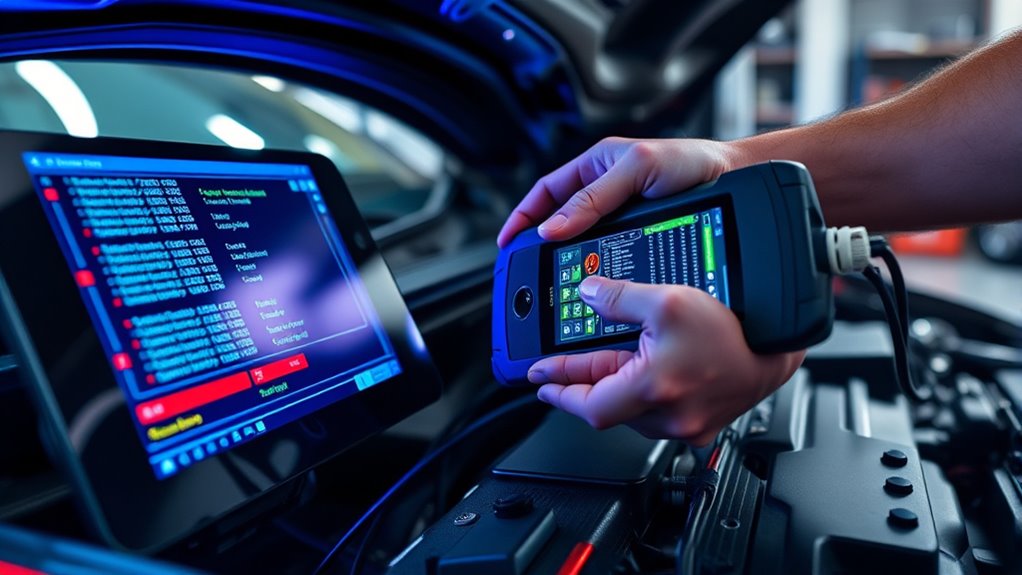
Reflashing the ECU with updated software involves a straightforward process that requires careful preparation and the right tools.
First, verify your laptop or PC is equipped with specialized software, like those from Car Computer Exchange or HPA Academy. Connect your device to the vehicle’s OBD2 port using a USB-to-OBD2 adapter.
Before starting, back up your original ECU data to avoid potential issues. Then, follow these steps:
- Download the factory calibration data via the software.
- Make necessary modifications to the data.
- Upload the revised data to the ECU.
- Confirm the upload’s success and restart your vehicle to apply the changes. Reflashing is a common and powerful method for tuning late model cars, allowing precise control over engine parameters. Ensuring a stable power supply during the process can prevent interruptions that might corrupt the data, especially since ECU remapping can be sensitive to power fluctuations. Maintaining a stable internet connection can help with remote reflashing options. Always double-check your connections before proceeding. Additionally, understanding the importance of software compatibility can help prevent issues during the process.
Verifying Performance and Ensuring Safety
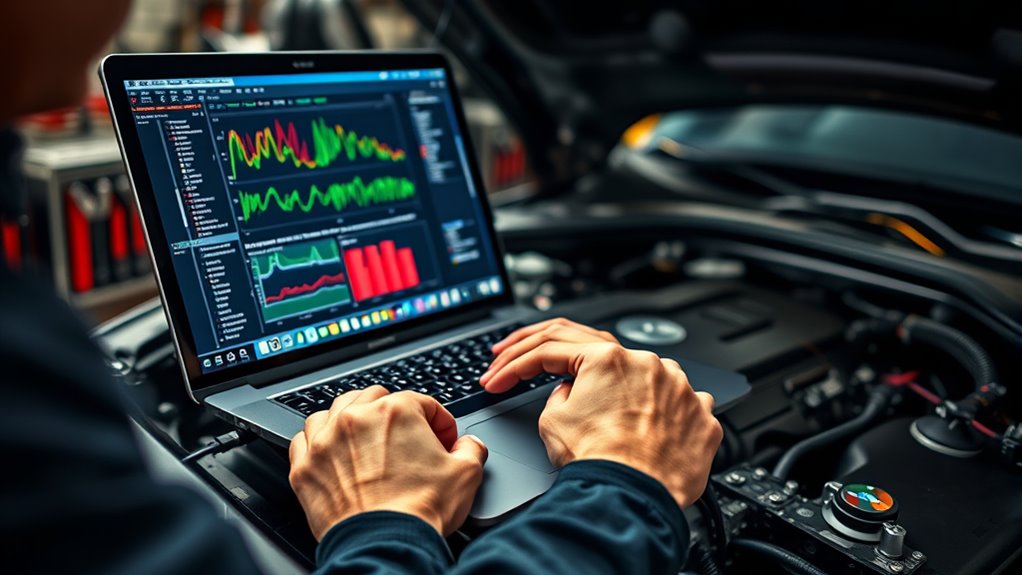
After completing the ECU reflash, verifying that the vehicle performs correctly and remains safe to operate is essential. Begin with final diagnostic checks to identify any issues that might’ve arisen during remapping. Diagnostic checks ensure that the ECU is functioning properly and that no error codes are present. Conduct road testing to evaluate real-world performance improvements. Use a dynamometer to measure power and torque precisely. Monitor live data such as temperature and pressure during testing to prevent damage and guarantee safe operation. Monitoring support hours and availability can help in case troubleshooting is needed during testing. Compare post-remap performance data with baseline figures to validate gains. Make fine-tuning adjustments if necessary, based on test results. Always confirm safety protocols are followed, like avoiding engine overstress and respecting manufacturer warranty restrictions. Additionally, understanding the benefits of proper calibration can help optimize the remapping process. These steps confirm your vehicle runs smoothly, safely, and as expected after remapping.
Selecting the Appropriate Remapping Stage
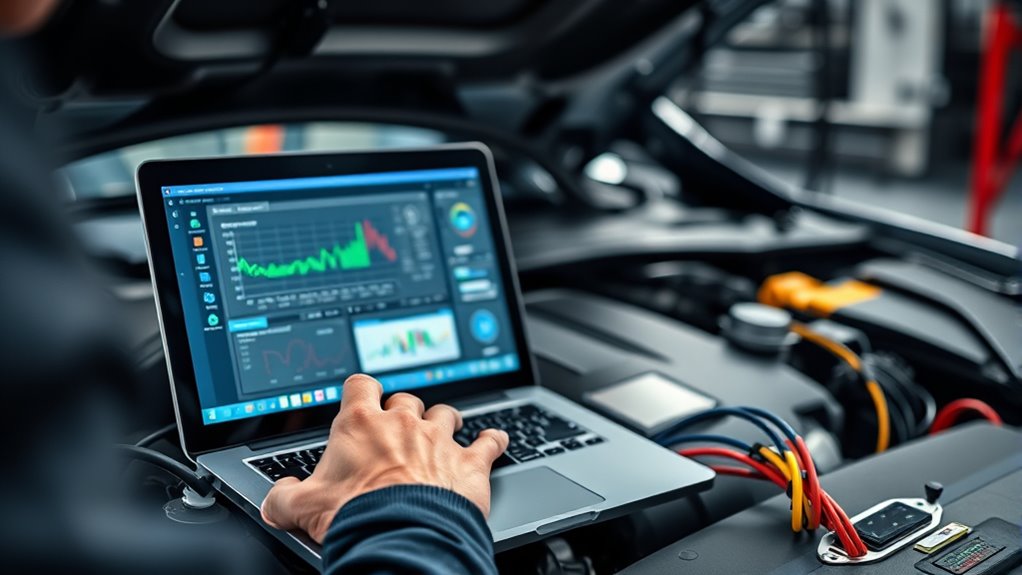
How do you determine the right remapping stage for your vehicle? First, assess your current hardware. If your car has stock components, Stage 1 may suffice for a safe, performance boost. A Stage 1 Remap is designed for fully stock components and is safe for the original exhaust, intake, intercooler, and catalytic converter. If you’ve upgraded parts like the turbo or exhaust, consider Stage 2 for further gains. For extensive modifications, including high-performance internals, Stage 3 offers maximum power but requires expertise. Next, define your goals—daily driving comfort, spirited driving, or racing. Budget is also vital; higher stages involve more hardware and tuning costs. Finally, think about reliability, fuel economy, and warranty implications. Use this checklist: 1. Hardware condition and upgrades 2. Performance goals 3. Budget constraints 4. Intended vehicle use Matching these factors helps you select the most suitable remapping stage.
Frequently Asked Questions
How Do I Choose a Reputable ECU Tuning Specialist?
When choosing a reputable ECU tuning specialist, you should look for someone with recognized certifications, proven success stories, and industry respect.
Make sure they’ve strong technical expertise, experience with various vehicle types, and are familiar with advanced tuning features like custom maps and boost control.
Check customer reviews and community recommendations, and guarantee they work with trusted brands.
This way, you can trust their skills to optimize your vehicle’s performance safely.
What Are the Legal Considerations for ECU Remapping?
Did you know that over 80% of vehicles fail emissions tests because of illegal modifications?
When considering ECU remapping, you must guarantee it complies with your local emissions and safety laws. You need to avoid illegal practices like DPF deletes, which can lead to hefty fines or vehicle impoundment.
Always choose a reputable specialist who understands regulations, and remember, non-compliance can void your warranty and result in legal trouble.
Can Remapping Void My Vehicle’S Warranty?
You might worry that remapping your vehicle will void your warranty, and in many cases, it can if it deviates from the original specs. Manufacturers often see remapping as a modification that could cause issues.
However, some remapping options are reversible, and getting approval from your manufacturer can protect your warranty.
Keep detailed records of any changes, and always check your warranty terms before proceeding.
How Long Does the Entire ECU Remapping Process Typically Take?
The entire ECU remapping process usually takes a few hours, depending on your vehicle and desired modifications. Basic remaps can be completed in 2 to 4 hours.
More complex or custom tunes might extend to a full day. Factors like vehicle type, tuning level, and tuner expertise influence the duration.
After reading the current settings and uploading the new map, testing and fine-tuning are essential steps to guarantee maximum performance.
What Are the Signs of a Poorly Tuned ECU?
Think of your ECU as the brain of your car; if it’s poorly tuned, it’s like a distracted thinker. You’ll notice increased engine temperatures, rough idling, and decreased fuel efficiency.
You might also experience sluggish acceleration, unstable boost, or difficulty starting. The check engine light may stay on, and your engine could run unevenly.
These signs warn you that your ECU isn’t performing at its best, risking engine damage and reduced lifespan.
Conclusion
Now, as you wrap up your ECU remapping journey, it’s almost like the perfect tune was waiting for you all along. By understanding your vehicle’s baseline, taking careful steps, and verifying performance, you’ve uncovered a hidden potential just beneath the surface. Sometimes, it feels like the universe nudges you toward the right upgrades at the right moment. With your new setup, you’re not just driving — you’re experiencing your car’s true power, all thanks to your careful touch.



